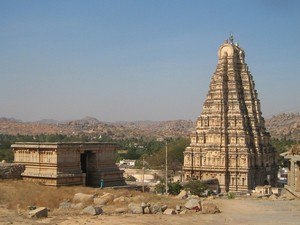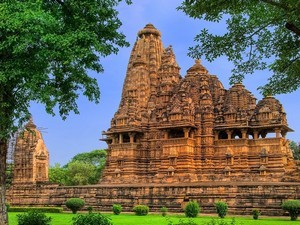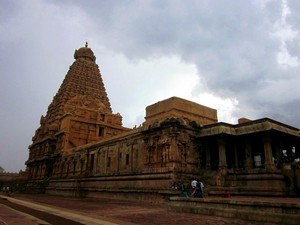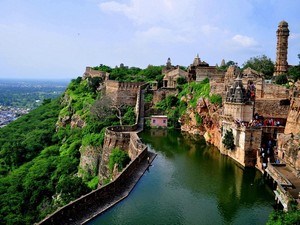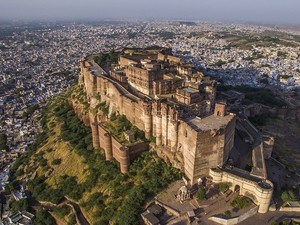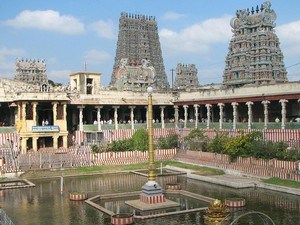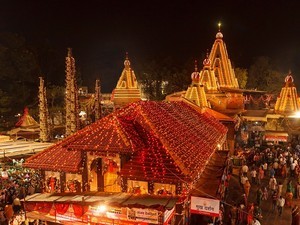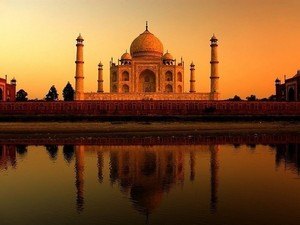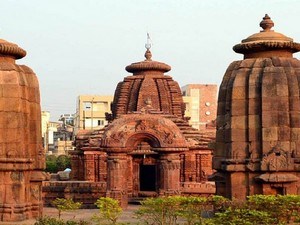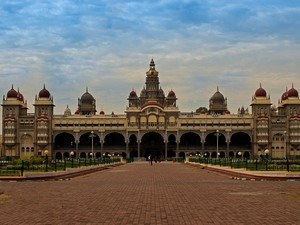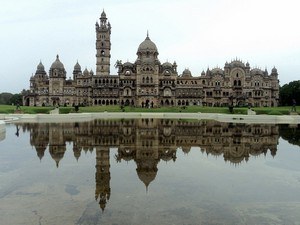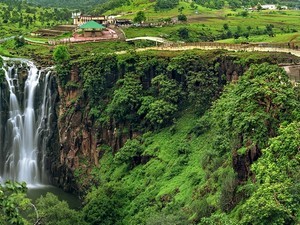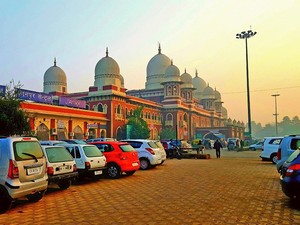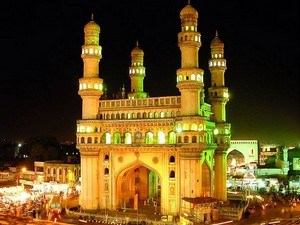1
DAY 1 : GWALIOR SIGHTSEEING
DAY 1 : GWALIOR SIGHTSEEING
 Travel from to
Travel from to
 Sightseeing
Sightseeing
Leisure / No Sightseeing
At a distance of 4 km from Gwalior Junction, Gwalior Fort is one of the most beautiful historical and architectural marvels situated in the center of Gwalior city. Known as the pearl amongst fortresses in India, Gwalior Fort is one of the best historical forts in India and also one of the top places to visit in Gwalior.
The fort was built by a local king, Suraj Sen in 8th century AD on a solitary rocky hill called Gopachal. According to legend, the king was cured of leprosy, when a sage named Gwalipa offered him the water from Suraj Kund, now lies within the fort. The king constructed a fort, and named it after the sage. Since then many dynasties ruled over the place from Tomars, Mughals, Marathas and the British. Finally, Gwalior Fort was acquired by Scindias in 1886 and ruled until the independence of India in 1947. It was here that Tatya Tope and Rani Jhansi Lakshmi Bai fought for their freedom.
Spread over an area of 3 sq. km, Gwalior Fort is one of the biggest forts in .....
 Duration of visit: 2-3 Hours
Duration of visit: 2-3 Hours
 Timings: 9 AM to 5.30 PM, Sound & Light Show: 7.30 PM (Hindi) & 8.30 PM (English)
Timings: 9 AM to 5.30 PM, Sound & Light Show: 7.30 PM (Hindi) & 8.30 PM (English)
At a distance of 1 km from Gwalior Fort and 3 km from Gwalior Junction, Tombs of Mohammed Ghaus & Tansen are situated in the town of Gwalior, Madhya Pradesh. Well known for its architecture, the tomb complex is one of the prominent sightseeing attractions in Gwalior.
The Tomb of Mohammad Ghaus was built in 16th century AD during the Akbar's rule. Ghaus Mohammed was an Afghan Prince who later converted into a Sufi saint. According to legend, Mohammad Ghaus assisted Babur when he was conquered the fort of Gwalior in 1526 CE. The Sufi saint who belongs to 16th century occupies an important position in the history of Mughal India and is said to have had great influence over Mughal emperors like Babur and Humayun.
Tomb of Ghaus Mohammed is a prominent pilgrimage center of both Muslims and Hindus. The structure of this tomb is typical Mughal architecture with hexagonal pillars stand at each of its four corners. The building is square in plan and topped by a square dome decorated .....
 Duration of visit: 15 Mins
Duration of visit: 15 Mins
 Timings: 9 AM to 5 PM
Timings: 9 AM to 5 PM
At a distance of 5 km from Gwalior Fort and 5 km from the Gwalior Junction, Surya Mandir or Sun Temple is a Hindu temple in the historic city of Gwalior, Madhya Pradesh. Situated near the Residency at Morar, Sun Temple is one of the most famous heritage monuments in Gwalior and also one of the top places to visit in Gwalior.
Dedicated to Sun God, Surya Mandir is one of the popular pilgrimage places in Gwalior. Also known as Vivaswan Temple, Surya Mandir was constructed in 1988 by G.D Birla, the famous industrialist of India. The Surya Mandir is a new one in the list of the grand historical monuments of Gwalior and it does not even have any historical significance.
The temple is the replica of the famous Sun Temple of Konark in Orissa. The temple is one of the architectural wonders and has a beautiful sculpture of Lord Surya in the temple premises. The temple building is created in the shape of chariot pulled by seven horses each one depicting seven days of the week. One can .....
 Duration of visit: 30 Mins
Duration of visit: 30 Mins
 Timings: 6 AM - 12 PM & 4 PM - 7 PM
Timings: 6 AM - 12 PM & 4 PM - 7 PM
2
DAY 2 : GWALIOR SIGHTSEEING
%%Itinerary_Title_Day2%%
At a distance of 2 km from Gwalior Junction and 3 km from Gwalior Kila, Gwalior Zoo is an ideal spot and also one of the most visited tourist attractions in Gwalior. Also known as Gandhi Prani Udhyan or Gandhi Zoo, Gwalior Zoo is one of the most beautiful zoological parks in Madhya Pradesh.
The Gandhi Zoo is a part of a huge garden known as Phool Bagh which was built by Madhao Rao Scindia in 1922 and it was inaugurated by Wales Prince in the same year. The Gwalior Zoo is maintained by the Municipal Corporation of Gwalior. The Phool Bagh campus also includes a gurudwara, a mosque, a theosophical lodge and a prayer hall.
Spread over an area of 8 hectares, Gwalior Zoo is home to some rare species of animals including a white tiger. The main animals which are present in the zoo are deer, monkeys, Royal Bengal Tiger, serpents, crocodile, spotted deer, sambhar, hyena, lion, rabbits, panther, bear, hippopotamus, etc. The zoo also has some rare and colorful birds, snakes, lizards, .....
 Duration of visit: 1 Hour
Duration of visit: 1 Hour
 Timings: 8 AM to 6 PM, Closed on Fridays
Timings: 8 AM to 6 PM, Closed on Fridays
At a distance of 2.5 km from Gwalior Junction and 4 km from Gwalior Fort, Jai Vilas Mahal or Jai Vilas Palace is a 19th century palace in Gwalior, India. It is one of the important heritage places in Gwalior city and was rated among the well maintained palaces of Madhya Pradesh state.
Jai Vilas Mahal was constructed in the year 1874 CE by Jayajirao Scindia, the Maharaja of Gwalior, at a cost of Rs. 1 crore. It is a fine example of European architecture, designed and built by Sir Michael Filose. The palace was the residence of the royal family of Scindia's. A segment of the Jai Vilas Palace was converted into a museum now.
The Palace is well-known for its beautiful architecture. The palace features a beautiful blend of Tuscan, Italian and Corinthian styles of architecture. Spread over an area of 12, 40, 771 square feet, the palace has 400 rooms and a huge Durbar Hall. The interior of the Durbar Hall is decorated with gilt and gold furnishings and adorned with a huge carpet .....
 Duration of visit: 30 Mins - 1 Hr
Duration of visit: 30 Mins - 1 Hr
 Timings: 10 AM to 4.30 PM, Closed on Mondays & on National Holidays
Timings: 10 AM to 4.30 PM, Closed on Mondays & on National Holidays
At a distance of 5 km from Gwalior Junction and 6 km from Gwalior Fort, the Chhatris are the memorial of Scindia dynasty rulers of Gwalior. Situated in Chhatri Bazar, the Chhattris of the Scindia dynasty are one among the prominent attractions in Gwalior city.
Renowned for its architectural brilliance and beautiful structures, the Chhatris are located in a beautiful garden. These are elevated, dome-shaped pavilions used as an element in Indian architecture. The first chhatri was built in 1817 CE to commemorate Jayaji Rao Scindia. Since then other Chhatris have been added. The older ones are built in yellow and pink sandstone and are of great architectural value.
Apart from others, the Chhatris of Jiwaji Rao Scindia, Daulat Rao Scindia and Janko ji Rao Scindia are well known. These Chhatris preserve the beauty of the medieval period and are decorated with stone carvings of elephants, horses and tigers. These monuments have been built with pink and white stones. There is a .....
 Duration of visit: 30 Mins
Duration of visit: 30 Mins
 Timings: 9 AM - 5 PM
Timings: 9 AM - 5 PM
End
 Travel from to
Travel from to
 Travel from to
Travel from to
END OF THE TOUR

